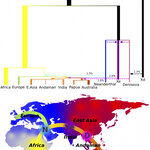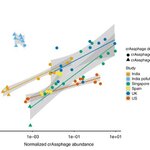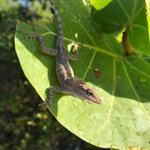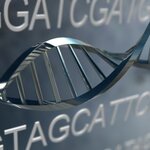Evolution

A recent study using deep learning algorithms and statistical methods discovered the footprint of a new hominid who cross bred with the ancestors of Asiatic individuals tens of thousands of years ago.
Modern human DNA computational analysis suggests that the extinct species was a hybrid of Neanderthals and Denisovans and cross bred with "Out of Africa" modern humans in Asia. This finding would explain that the hybrid found this summer in the caves of Denisova - the offspring of a Neanderthal mother and a Denisovan father - was not an isolated case, but rather was part of a more general…

Fecal pollution can explain a lot of the increase in resistant bacteria where humans live, but not all of it. In some cases resistance genes were common without the presence of “crAssphage”, a bacteriophage common in human feces - environments polluted with high levels of antibiotics from manufacturing, according to a new paper.
Antibiotic resistance is nature at work. Bacteria survived for billions of years by adapting to things, including other parts of nature and antibiotics, designed to kill them. In some instances, the antibiotic resistance problem was accelerated by "defensive"…

An ancient genetic mechanism needed for plant fertility is helping to solve a science mystery 700 million years in the making.
The researchers discovered how a gene called DUO1 known to control sperm production inside pollen grains of flowering plants, is also used by primitive land plants to produce free-swimming sperm. They found that the gene originated in the stoneworts, an ancient group of aquatic algae that diverged from land plants over 700 million years ago.
The paper suggests that it was a simple change in the DUO1 gene sequence that allowed the algal ancestors of land plants to…

Oxygen in the Earth’s atmosphere is necessary for complex forms of life, which use it during aerobic respiration to make energy. The levels of oxygen dramatically rose in the atmosphere around 2.4 billion years ago, and speculation is that is when organisms called cyanobacteria, which perform the same type of organic photosynthesis that all plants do today, first evolved, and could perform oxygen-producing (oxygenic) photosynthesis.
Perhaps cyanobacteria could have evolved before 2.4 billion years ago but something prevented oxygen from accumulating in the air.
A research team have…

The transition from ape-like shuffling to upright walking (bipedalism) as we do has long fascinated scientists. Why did it happen? When?
The second question is a little closer to being solved. An analysis of 3.6 million year old hominin footprints in Tanzania suggests our ancestors evolved the hallmark trait of extended leg, human-like bipedalism substantially earlier than previously thought. Many millions of years before humans. Like the chicken and the egg, there is a clear science answer about which came first even if philosophers are baffled.
As you'd expect, fossilized footprints…

In the 1800s, critics of evolution insisted there had to be fossil evidence for everything, which neglected the idea that fossilization is already difficult, finding the fossil is even more difficult, and something like an eye will not fossilize at all.
But detractors who insisted they would not accept evolution until they found a "missing link" between modern humans and ancestral primates would be moving the goalposts once again, because a fossil of an ancient hominin individual from Siberia had a Neanderthal mother and a Denisovan father.
Until 40,000 years ago, there were two known…

A technique used to produce stone tools that were first found 500,000 years ago is likely to have needed a modern human-like hand, according to new research.
The technique is called 'platform preparation' - preparing a striking area on a tool to remove specific stone flakes and shape the tool into a pre-conceived design - and without the ability to perform highly forceful precision grips, our ancestors would not have been able to produce advanced types of stone tool like spear points.
Platform preparation is essential for making many different types of advanced prehistoric stone tool,…

The 2017 hurricane season was one of the most expensive in the Atlantic Ocean region. Hurricane Harvey hit in mid-August 2017, followed just a few weeks later by Hurricane Irma and Hurricane Maria in September. Each of these storms had winds in excess of 125 mph, with Irma up to 170 mph. Damage from totals for the hurricane season topped $282 billion. And now scientists know they even caused a kind of artificial selection - by changing natural selection. For tropical anole lizards living on the more remote cays of Turks and Caicos, there was only the ones who survived — and the…

It isn't just human adults who regard youth as disease factories, in many species the young are often more susceptible to infection than adults, even after accounting for prior exposure to infection.
Evolution has an explanation for that. But like a lot of things in evolution, it may seem puzzling.
It shouldn't make sense, since dying young or becoming infertile due to infection means organisms will be unable to reproduce, but many species may have evolved to prioritize growth over immunity while maturing. And that complexity may be why immunity varies with age in different species.
Humans…

From a young age, children have a nuanced understanding of how free markets work. A new study in Child Development indicates that children as young as five incorporate market concerns—the idea that what you get is in line with what you give or offer—into their decision making, and increasingly do so with age.
Some people think children are innately selfish, they want to get goodies for themselves, while others insist they are more communist, each will do more to help those who can't or won't do enough. By studying how children engage in different types of exchanges, researchers hope to…